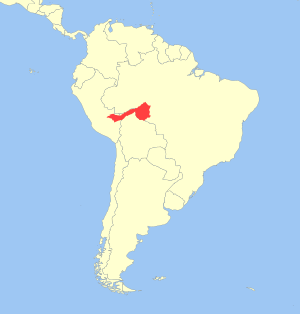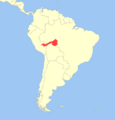Brown titi monkey facts for kids
Quick facts for kids Brown titi |
|
|---|---|
 |
|
| At the National Zoo | |
| Conservation status | |
| Scientific classification | |
| Genus: |
Plecturocebus
|
| Species: |
brunneus
|
 |
|
| Geographic range (includes P. urubambensis) | |
| Synonyms | |
|
Callicebus brunneus Wagner, 1842 |
|
The brown titi monkey (Plecturocebus brunneus) is a small, furry monkey that lives in South America. It's a type of titi monkey, which are also known as "New World monkeys." This means they live in Central and South America. The brown titi monkey is special because it is found only in Brazil. Scientists first described this monkey in 1842. Later, in 2016, they moved it into a new group of monkeys called Plecturocebus.
Contents
What is a Brown Titi Monkey?
Family Tree of Titi Monkeys
The brown titi monkey belongs to a larger group of monkeys called Callicebinae. This group includes other living titi monkeys like Cheracebus and Callicebus. There were also some titi monkeys that are now extinct, meaning they no longer exist.
For a while, scientists thought the Urubamba brown titi from Peru was the same as the brown titi. But in 2015, a study showed it was actually a different species. This study also found it was more closely related to the white-eared titi. Because of this, the brown titi monkey is now known to live only in Brazil.
How Do Brown Titi Monkeys Look and Live?
Unique Features of Brown Titis
Brown titi monkeys share many traits with their relatives. However, they have a special mix of features that make them unique. Their heads and backs are a greyish-brown color. Their bellies are a bright reddish-brown. Their tails are mostly black with a light tip. They have light yellow hair on their cheeks and bright reddish-brown hair on the sides of their faces.
All titi monkeys have furry tails that can grasp things, like branches. Scientists can tell different titi species apart by looking at these unique combinations of colors and features. This is how the brown titi monkey was recognized as its own species.
What Do Brown Titis Eat?
Like other titi monkeys, their diet mainly consists of fruits. They also eat flowers, leaves, insects, and sometimes small animals.
Where Do Brown Titis Live?
Brown titi monkeys live in a dry forest area in Brazil called the Caatinga. Titi monkeys are very protective of their homes. They will shout loudly to warn off predators or other animals that come too close.
Brown Titi Family Life
Brown titi monkeys give birth to live young, usually one baby after about five months of pregnancy. All titi monkeys are monogamous, which means they mate with only one partner for their entire lives. They live in small family groups, usually made up of the parents and their offspring.
Why are Brown Titi Monkeys in Danger?
Main Threats to Their Survival
The biggest danger to brown titi monkeys in the Brazilian state of Rondônia is human development. When people build houses, roads, or farms, they destroy the monkeys' natural homes. Other threats include roads and power lines, where monkeys might get hurt trying to cross. Dams and water projects also affect their habitat. Sometimes, though rarely, they are hunted for food by local people.
How Are We Protecting Brown Titi Monkeys?
Conservation Status
In 2020, the brown titi monkey was listed as "vulnerable" by the IUCN Red List. This means they are at risk of becoming endangered. Scientists don't know exactly how many brown titi monkeys are left, but their numbers seem to be going down. It's thought that only about 250 adult monkeys remain.
What is Being Done to Help?
Efforts to protect these monkeys include educating people and protecting their habitats. The brown titi is part of international laws that control trade and manage wildlife. Also, there are special conservation areas where these monkeys live, helping to keep them safe.
Images for kids
See also
 In Spanish: Tití marrón para niños
In Spanish: Tití marrón para niños




